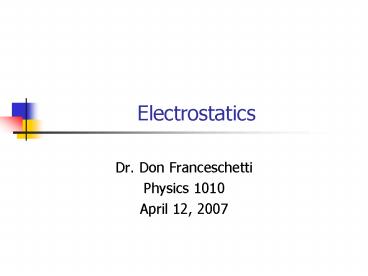Electrostatics
1 / 36
Title: Electrostatics
1
Electrostatics
- Dr. Don Franceschetti
- Physics 1010
- April 12, 2007
2
Electromagnetism in ancient times
- Atmospheric Electricity
- Electric Fish
- Torpedo (used by Roman physicians)
- Electrophorus
- Amber (elektron)
- Lodestone
3
Thales of Miletus 624-527 B.C.E.
- Knew about static electricity.
- Knew about the lodestone.
4
William Gilbert, M. D.
Wrote De Magnete and distinguished electrical
from magnetic phenomena.
5
Robert Symmer 1759
- Beginnings of two fluid theory
- Wore silk stockings over worsted.
- On taking the two stockings off together and
then drawing the one from inside the other, he
found that both became inflated so as to
reproduce the shape of the foot, and exhibited
attractions and repulsions at a distance of as
much as a foot and a half.
6
Abbé Jean Nollet
- Conducted electricity demonstrations in the
salons of Paris. - Rival of Ben Franklin
7
Dr. Ben Franklin
One fluid theory Lightning rod Debunked Mesmer
8
Luigi Galvani M.D.
9
Count Allesandro Volta
Voltaic Pile, first source of current electricity
10
AldiniGalvanis nephew
- Went on the road to popularize electricity.
- Visited England with shocking literary results.
11
Sir Humphrey Davy
Used electrolysis to discover new elements. Did
public demonstrations using cadavers
12
Mary Shelly
13
Getting serious now
- Electric charges can be positive or negative.
- Bulk matter is positively charged if it has fewer
electrons than protons. - Bulk matter is negatively charged if it has more
electrons than protons. - Electrons get transferred when dissimilar
materials are rubbed against each other. This is
static electricity.
14
An electric relationship
15
Attraction and Repulsion
16
Charge is
- Conserved (a new conservation law)
- Quantized (comes in packages of proton size
charges) - Electrical force is so much stronger than
gravitational force that it is real hard to build
up a large concentration of charge.
17
Conductors and Insulators
- Conductors (metals) Electrons are free to move
over large distances. - Insulators Electrons not free to move.
- Semiconductors are intermediate in character.
Both electrons and holes contribute to
conduction. Very sensitive to doping. - Superconductors Materials that exhibit zero
resistance below a certain temperature.
18
Tricks for storing charge
- Use parallel metal plates (capacitor or Leyden
jar) separated by a thin insulator. - Excess charge arranges itself to screen out
electric field inside conductors (van de Graff)
19
A Capacitor
20
The Coulomb
- 1 coulomb (C) is a lot of charge.
- Elementary charge is 1.6x10-19C.
- Charge on protons in 1 g. of hydrogen is 96,500 C.
21
Coulombs Law
- F kq1q2/d2
- K9,000,000,000 Nm2/C2
- An inverse square law like the law of gravity but
can be either attractive or repulsive and much
stronger.
22
Charging
- Can occur by contact.
- Or induction.
- Lightning charged area of cloud induces opposite
charge in ground below. - Sharp points allow discharge. Franklins
lightning rod.
23
Charging by induction
24
Lightning protection
25
Charge Polarization
- Rearranges charges on an atomic scale.
- Electronic and or dipolar reorientation
- Carried to extreme rips electrons out entirely to
produce spark or lightning bolt
26
Polarization
27
Induced Polarization
28
Water has a permanent dipole
29
Because of the dipole in water
- Water is a liquid at room temp.
- Water expands when it freezes.
- Salt dissolves in water.
- Ponds do not freeze completely in winter!
- And life as we know it is possible.
30
Electric Field
- EF/q, measured in N/C
- Points in direction of force on a positive
charge. - Field lines start on positive charges and end on
negative ones. - Microwave oven is source of alternating electric
field, drags molecules around, creates heat.
31
Electric Shielding
- No electric field inside a conductor.
- Recall van de Graaff
32
van de Graaff
33
Electric Potential
- Moving electrically charged objects subject to
electrical forces changes their potential energy. - Electric potential
- Electric potential energy/charge
- volt joule/coulomb
34
Review questions
- 22.1 In terms of attraction and repulsion, how do
negative particles affect negative particles? How
do negatives attract positives? - 22.2 Why does the gravitational force between the
Earth and moon predominate over electrical forces.
35
Review Questions
- 22.6 What is a positive ion? A negative ion?
- 22.7 What do we mean by saying charge is
conserved? - 22.8 What is meant by saying charge is
quantized. - What particle has exactly one quantum of charge?
36
Review questions
- 22.20 Give an example of something charged by
induction. - 22.21 What occurs when we ground an object?
- 22.22 What is the purpose of a lightning rod?































